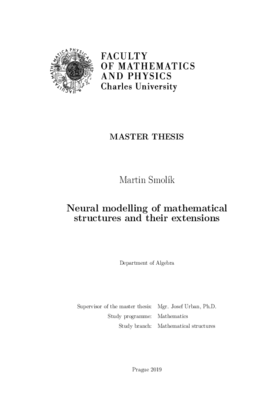Neural modelling of mathematical structures and their extensions
Neuronové modelování matematických struktur a jejich rozšíření
diplomová práce (OBHÁJENO)

Zobrazit/
Trvalý odkaz
http://hdl.handle.net/20.500.11956/110058Identifikátory
SIS: 214912
Kolekce
- Kvalifikační práce [11978]
Autor
Vedoucí práce
Oponent práce
Holub, Štěpán
Fakulta / součást
Matematicko-fyzikální fakulta
Obor
Matematické struktury
Katedra / ústav / klinika
Katedra algebry
Datum obhajoby
12. 9. 2019
Nakladatel
Univerzita Karlova, Matematicko-fyzikální fakultaJazyk
Angličtina
Známka
Velmi dobře
Klíčová slova (česky)
Umělá inteligence Automatické uvažovaní Strojové učení Teorie modelůKlíčová slova (anglicky)
Artificial Intelligence Automated Reasoning Machine Learning Model theoryV tejto práci sa snažíme vybudovať algebraické modely v počítači použitím strojového učenia, konkrétne neurónových sietí. Začneme množinou axiómov ktoré popisujú funkcie, konštanty a relácie a použijeme ich na trénovanie neurónových sietí ktoré ich aproximujú. Každý prvok je reprezentovaný reálnym vektorom, aby na nich neurónové siete mohli operovať. Taktiež skúmame a porovnávame rôzne reprezentácie. Táto práca sa zaoberá hlavne grupami. Trénujeme neurónové reprezentácie pre cyklické (najjednoduchšie) a symetrické (najkomplikovanejšie) grupy. Ďalšou časťou tejto práce sú experimenty s rozšírením týchto natrénovaných modelov pomocou "alge- braických" prvkov, podobne ako klasické rozšírenia racionálnych čísel, napr. Q[ √ 2]. 1
In this thesis we aim to build algebraic models in computer using machine learning methods and in particular neural networks. We start with a set of axioms that describe functions, constants and relations and use them to train neural networks approximating them. Every element is represented as a real vector, so that neural networks can operate on them. We also explore and compare different representations. The main focus in this thesis are groups. We train neural representations for cyclic (the simplest) and symmetric (the most complex) groups. Another part of this thesis are experiments with extending such trained models by introducing new "algebraic" elements, not unlike the classic extension of rational numbers Q[ √ 2]. 1
